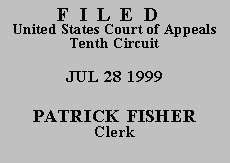 UNITED STATES COURT OF APPEALS
UNITED STATES COURT OF APPEALS
 UNITED STATES COURT OF APPEALS
UNITED STATES COURT OF APPEALS
TENTH CIRCUIT
| UNITED STATES OF AMERICA, | |
| v. | No. 98-4168 |
| MARTIN DELUNA-NUNEZ, | (D.C. No. 98-CR-228)
(D. Utah) |
ORDER AND JUDGMENT(*)
Before SEYMOUR, Chief Judge, BALDOCK, and HENRY, Circuit Judges.(**)
Agents from the Immigration and Naturalization Service ("INS") apprehended Defendant Martin DeLuna-Nunez in St. George, Utah on April 22, 1998. Defendant had previously been deported from the United States on May 23, 1997. Defendant was charged with and pleaded guilty to illegal reentry into the United States after deportation, in violation of 8 U.S.C. § 1326. The court sentenced Defendant to 37 months of imprisonment. In doing so, the district court enhanced Defendant's sentence by sixteen levels pursuant to U.S.S.G. § 2L1.2(b)(1)(A). On appeal, Defendant challenges the applicability of the sixteen-point sentence enhancement. Our jurisdiction arises under 18 U.S.C. § 3742(a). We affirm.
The base offense level for illegal reentry is eight. See U.S.S.G.
§ 2L1.2(a). In this case, the district court increased the base offense level by sixteen pursuant to § 2L1.2(b)(1)(A), resulting in an adjusted offense level of twenty-four. The district court then reduced the adjusted offense level by three for acceptance of responsibility, resulting in a total offense level of 21. The district court also reduced Defendant's criminal history category from a IV to a I because the court found that the seriousness of the defendant's criminal history was significantly overrepresented in the presentence report. As a result, the applicable guideline range in this case was thirty-seven to forty-six months. Defendant challenges only one aspect of his sentence. He argues that the district court erred by applying the sixteen-level enhancement pursuant to § 2L1.2(b)(1)(A) of the sentencing guidelines. That section provides as follows:
(1) If the defendant previously was deported after a criminal conviction, or if the defendant unlawfully remained in the United States following a removal order issued after a criminal conviction, increase as follows (if more than one applies, use the greater):
(A) If the conviction was for an aggravated felony, increase by 16 levels.
The application notes for § 2L1.2 provide that an "aggravated felony" is defined at 8 U.S.C. § 1101(a)(43). The relevant portion of § 1101(a)(43) defines "illicit trafficking in a controlled substance (as defined in section 802 of Title 21), including a drug trafficking crime (as defined in section 924(c) of Title 18)" and "a theft offense . . . or burglary offense" as aggravated felonies. In this case, the district court applied the
§ 2L1.2 sentence enhancement based on Defendant's conviction on May 9, 1997, in Idaho for felony possession of methamphetamine, and on Defendant's July 27, 1989, conviction for first degree burglary in California. Defendant argues that neither the drug possession or burglary convictions qualify as an aggravated felony under § 2L1.2. Therefore, he argues the district court erred by enhancing his sentence sixteen levels. We review the district court's interpretation of a sentencing guideline de novo. United States v. Aranda-Hernandez, 95 F.3d 977, 981 (10th Cir. 1996).
Defendant argues that simple possession of a controlled substance does not constitute an aggravated felony. We disagree. A state conviction for possession of a controlled substance constitutes an aggravated felony for purposes of § 2L1.2. See United States v. Valenzuela-Escalante, 130 F.3d 944, 946-47 (10th Cir. 1997). Defendant was convicted on May 9, 1997, for drug possession, a crime we have previously held constituted an aggravated felony. See id. He was subsequently deported on May 23, 1997, and then reentered the United States illegally in April 1998. Accordingly, the district court did not err by applying the § 2L1.2 sixteen-level enhancement based on Defendant's May 9, 1997, state conviction for drug possession.
Defendant also challenges the district court's reliance on his 1989 burglary conviction to enhance his sentence. We need not reach the merits of this argument, however, because we hold above that the felony drug conviction qualifies as an aggravated felony under § 2L1.2. Section 2L1.2 requires only one aggravated felony in order to increase the offense level by sixteen levels. See § 2L1.2(b)(1)(A) ("if the conviction was for an aggravated felony, increase by 16 levels").
AFFIRMED.
Entered for the Court,
Bobby R. Baldock
Circuit Judge
*. This order and judgment is not binding precedent, except under the doctrines of law of the case, res judicata, and collateral estoppel. The court generally disfavors the citation of orders and judgments; nevertheless, an order and judgment may be cited under the terms and conditions of 10th Cir. R. 36.3.
**. After examining the briefs and appellate record, this panel has determined unanimously to honor the parties' request for a decision on the briefs without oral argument. See Fed. R. App. P. 34(f). The case is therefore ordered submitted without oral argument.